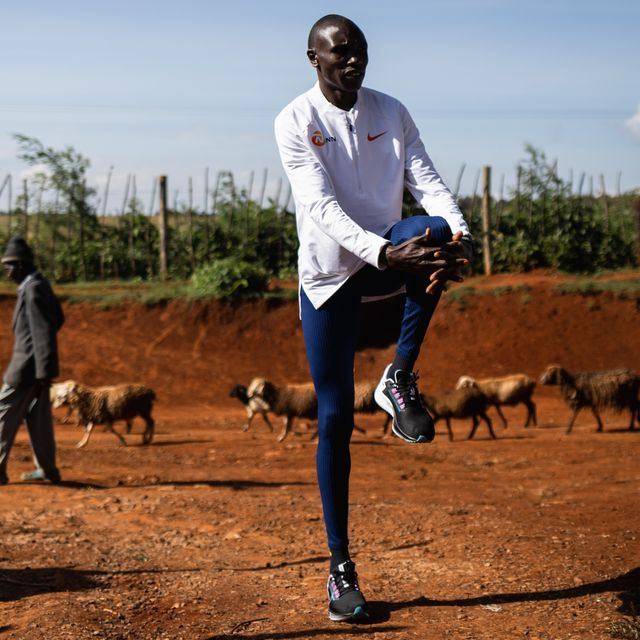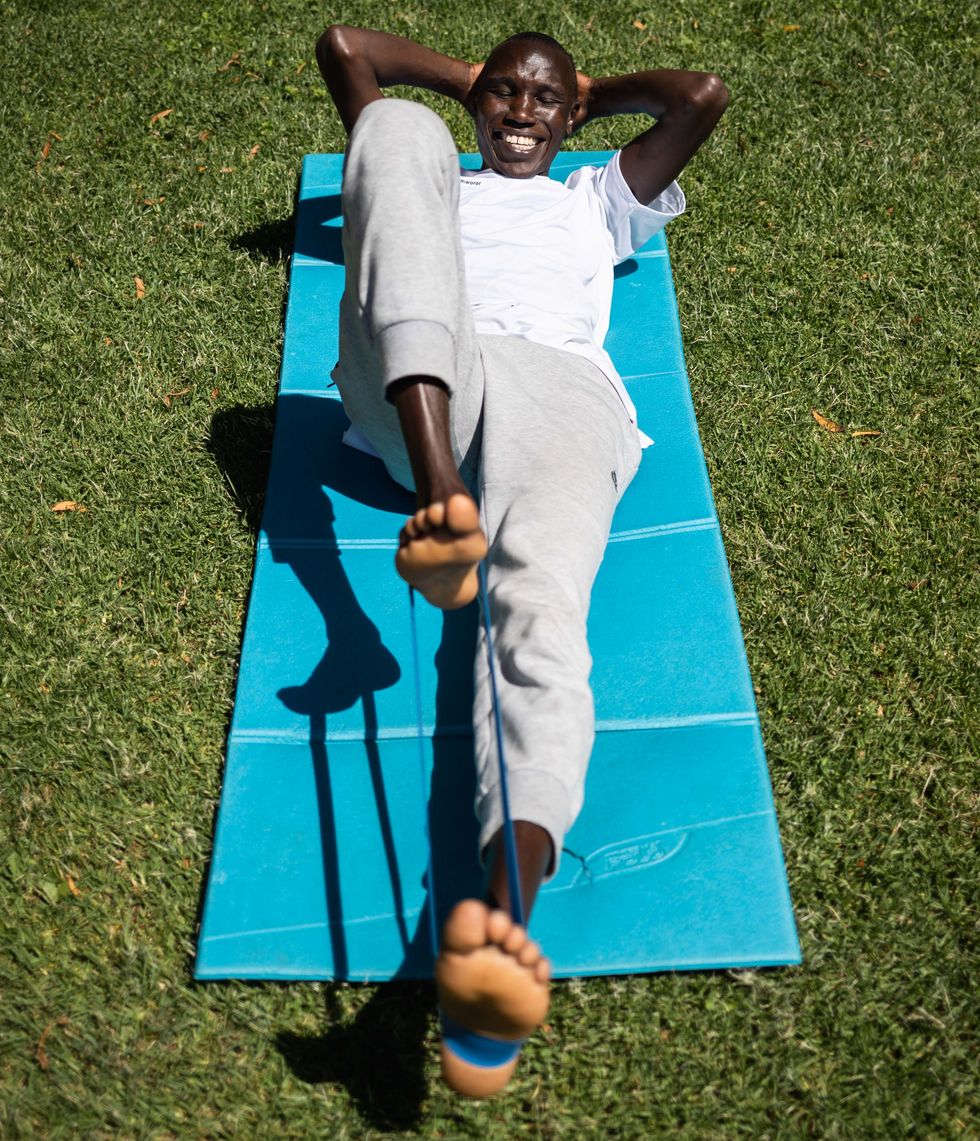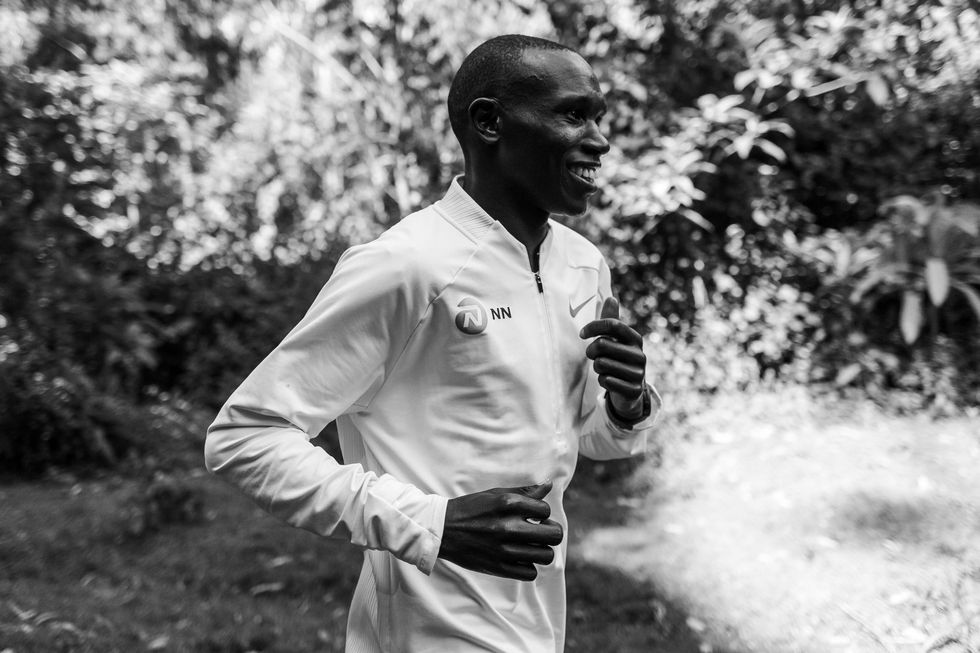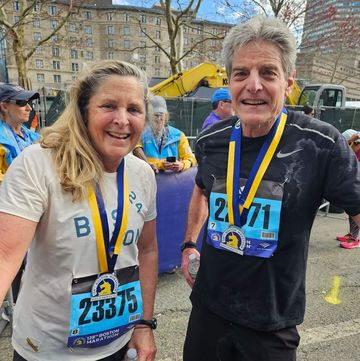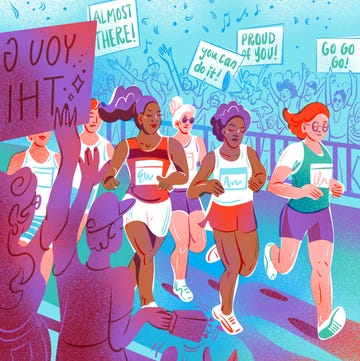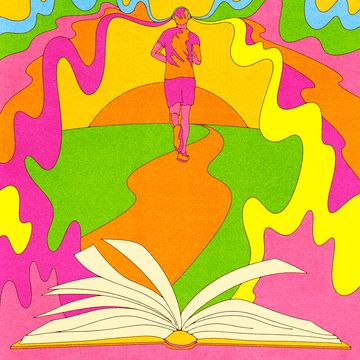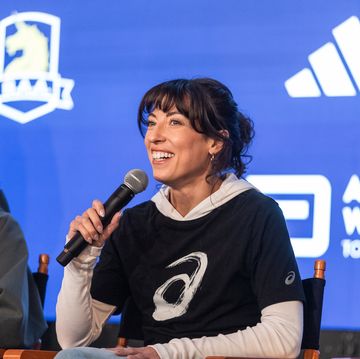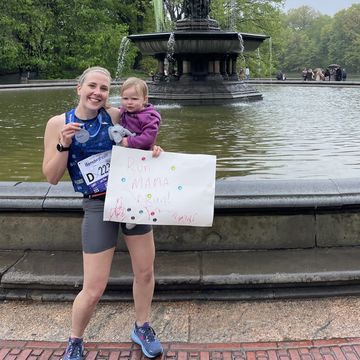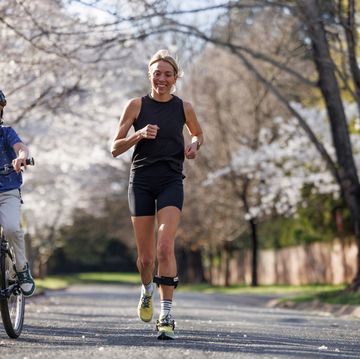For close to a decade, Thursday mornings have always meant one thing for Geoffrey Kamworor: A long, hard effort of 30-40 kilometers. It’s one of the key workouts that has built the 29-year-old Kenyan distance running star into the athlete he is: A two-time winner of the New York City Marathon, a three-time world half marathon champion, and two-time World Cross-Country champion.
So when he went out for his long run on June 25, 2020, it was just an ordinary run—at least at its outset. The only thing different about this was that Kamworor was alone.
In non-pandemic times, the Kenyan star would do all of his workouts, including his Thursday long run, with training partners at the NN Running Team camp in Kaptagat, Kenya. That meant going toe-to-toe a few times a week with Eliud Kipchoge, his friend and mentor—and the fastest marathoner ever. But COVID-19 regulations last year forced them to disband their camp for several months, and Kamwowor returned to his family home a half-hour away in Eldoret.
On that morning in June, Kamworor was about one kilometer from his house, just starting his run, when his world came crashing down. A person driving a motorcycle slammed into him from behind, failing to spot him in the pre-dawn darkness. The impact was so strong that Kamworor initially thought he’d been hit by a car.
“I was really afraid it [would] ruin my life or my career,” he told Runner’s World.
Through the adrenaline-fueled shock, he rose to his feet, assessing the damage. His head was cut and his shin ached, but Kamworor could walk, which made him think he’d had a lucky escape. But then the pain escalated.
The motorcyclist gave him a ride to the hospital, where Kamworor underwent an X-ray. The news wasn’t good: his right tibia was fractured in the crash, with multiple pieces of the bone breaking off during the impact. Kamworor underwent surgery that day to repair the bone. It would be five months before he’d run another step.
Join Runner's World+ for unlimited access to the best training tips for runners
Kamworor had never been seriously injured before in his running career, and that was part of why this recovery period was so difficult for him. For elite athletes, the battle back from injury can be as much mental as physical, the sudden incapacitation creating a psychological burden that can take some time to leave. The better the athlete, the more they tend to suffer, their identities so often tied up in their ability to execute this one, simple task.
Sixteen months on from the crash, sitting in the gardens of his training camp in Kaptagat, he reflected on it with the wisdom that it could have been much worse. He knows how fortunate he is to not only have recovered, but to be lining up to race the Valencia Marathon on Sunday, December 5.
“When I look back,” he said, “I feel I was lucky.”
Kamworor knows it could have spelled the end—to his career, if not his life.
“The injury was not good at all,” he said. “The doctor said it was a terrible injury to handle.”
Becoming a Running Star
For Kamworor, running has long been an obsession. When he was young, he’d run three kilometers to and from school each day, coming home for lunch in between, for a daily tally of 12K. In high school, he always fared well in inter-class races, but only after completing his studies in 2010 did he start training properly.
In a bid to earn a scholarship to university, he took part in two time trials, winning them both—but he instead decided to go pro. He joined a friend on a summer trip to Finland, racing weekly on the track and eking out a living from the mediocre prize money.
“Life was really tough,” he said.
After returning to Kenya, Kamworor won a half marathon, and was subsequently introduced to Patrick Sang, the renowned coach who has guided the career of Kipchoge, among many other champions. He’s has been under Sang’s guidance ever since.
The regimented, professional structure of Sang’s group helped him rise to the top of the world at both cross country and on the roads. Kamworor won silver in the 10,000 meters on the track behind Mo Farah at the 2015 IAAF World Championships. In September 2019, he broke the half marathon world record in Copenhagen, clocking 58:01. (It’s since been broken four times, making him the fifth-fastest half marathoner right now.)
Then, a Huge Setback
At the beginning of 2020, Kamworor was preparing to win his fourth consecutive world half marathon title when the world went into lockdown because of COVID-19. Amid many downfalls, the pandemic did have some advantages for Kamworor. When he’s training hard, Kamworor spends five days each week away from his family, but the restrictions meant he was at home when his wife, Ellyjoy, gave birth to triplets. Elian, Eliam and Eliana joined in June last year. They were born just two weeks before Kamworor was hit by the motorcycle.
“The whole family was very scared, especially my parents,” he said. “It was difficult, but my wife was very strong. She could handle the situation and was always there to assist me.”
In recovery, Kamworor spent two months on crutches and was told to rest as much as possible. In September last year, he began rehabbing with non-weight-bearing exercises, and started recovering his fitness on a stationary bike. In late October, he began some weight-bearing rehab, and a month later, he was doing some very light running. His leg still ached, but that was due to issues surrounding the tibia rather than the bone itself. By January, he was again running pain-free.
Kamworor won his first race back—a local cross-country 10K in late January. In April, he clocked 59:38 to finish second at the Istanbul Half Marathon, just three seconds behind fellow Kenyan Kibiwott Kandie, who broke Kamworor’s world record in Valencia last December with 57:32. (Jacob Kiplimo broke Kandie’s record at the Lisbon Half Marathon on November 21, running 57:31.)
His confidence restored, Kamworor went back into training with his eyes firmly fixed on the Tokyo Olympics. At the Kenyan Trials in late June, he routed the field to win the 10,000m in 27:01.06, the quickest time ever run at altitude.
The message went out to the world: Kamworor was back.
But the good times didn’t last. In July, just two weeks before the Olympics, Kamworor felt pain on the top of his foot. The injury required four weeks of rest.
“My body was still adjusting from the accident,” he said.
Having fought so hard to salvage his Olympics, Kamworor had no choice but to withdraw from the Games, watching from home as the men’s 10,000 meters played out without him.
“When it was being run, I was walking around the house,” he said. “I was not able to sit down, I was having feelings like you are running yourself. You feel you could be there.”
“Yes, yes,” he said, when I asked if he felt angry. “It was difficult not to be in Tokyo. It’s something I was really expecting, to be there, to work hard and get a medal.”
Growing Through Recovery
To make a successful return from injury, and avoid self-sabotage, athletes often need to engage in an act of amnesia: Forgetting about who they were and how easy it once was, and start fresh, rebuilding their bodies from the ground up.
For Kamworor, regaining his fitness has involved a painstaking commitment to rehab exercises, which he still does three times a week for an hour.
“It’s been very difficult, but that’s what you expect,” Peter Nduhiu, Kamworor’s physical therapist of 10 years, told Runner’s World. “That was a freak accident. It messed us up. But that is what is called fate.
“Geoffrey is a big engine. You’ve an engine that gives a lot of power, and the legs can fall apart if it’s not balanced out. But he’s an easy guy to work with. Give him instructions and he’ll follow them to the letter, just like Eliud.”
Sang also saw the struggles Kamworor went through, and he’s seen the person he’s become because of them.
“He grew in many ways,” Sang told Runner’s World. “The break and challenge allowed him to reflect and he came back stronger, mentally. He’s more professional now. Whatever the doctor says, he follows religiously.”
On a sunny Wednesday morning in mid-October, that was clear during the team’s strength and conditioning session. Among a dozen world-class athletes, Kamworor excelled at executing the right technique on most exercises, a by-product of how much time he’s spent doing them over the last year.
The injuries have forced him to adapt his workload. Before the crash, Kamworor ran 180 kilometers/week (almost 112 miles/week), but these days, his weekly mileage is closer to 150K/week (about 93 miles/week). His routine, otherwise, is largely the same: he does 10 miles of track reps on a Tuesday, a 30K or 40k long run on a Thursday, and a 50-minute fartlek session on a Saturday. The rest of his week is easy running.
It’s a spartan life, with Kamworor hugging his family goodbye every Monday morning before relocating to the training camp, where he stays until Saturday afternoon.
“They understand,” he said of his five children. “They know our team programs, and before they go to school on Monday, they come to me and say goodbye. I talk with them every day.”
Kamworor’s sacrifices are a means to an end, and he’s got some big ambitions in the years ahead. He will be 31 come the Paris Olympics in 2024, which should see him at his peak—if he can stay healthy on the road there.
Up Next: The Valencia Marathon—and the Olympics
When Runner’s World visited his training camp in mid-October, it was clear it still wasn’t smooth sailing for him just yet. Kamworor didn’t take part in the group track session or hard 30-kilometer run that week, but he was seen running alone at a leisurely pace.
“My health is good, things are good,” he said when asked if something was amiss. “Coming from an injury can be hard, the body is still adjusting, (but) I’m doing well.”
These days, those around Kamworor can see a difference in him: It’s not physical but psychological, the injuries fueling a desire to return even better than he was before.
“He’ll get faster, I think,” Nduhiu said. “The beauty of these things, when they happen, is that very talented elite athletes come back much stronger because it challenges their mind to prove a point.”
Having overcome what he has, Kamworor can see the upside to it.
“When you encounter the problem it’s something you don’t want,” he said. “But injury is part of the sport sometime; you have to take it positively and come out stronger.”
On Sunday, he will aim to do just that, racing his first 26.2 since the crash. In Valencia, Spain, he will take on a field of astonishing depth in a city that holds great memories: It’s where Kamworor won the half marathon world title in 2018, splitting a mind-boggling 13:01 5K in the latter part of the race.
“I’m optimistic for something great, something special,” he said. “I’m really glad to be at the starting line.”
Kamworor’s marathon best of 2:06:12 dates back to the 2012 Berlin Marathon. In recent years he hasn’t raced on any quick courses, instead putting his cross-country pedigree to use in New York, where he finished second, first, third, and first on his last four tries.
In Valencia, he will have to substantially rewrite his personal best to come home in front, with five 2:03 runners in the field and a course that’s renowned for fast times.
What does his coach expect?
“I don’t set targets for them,” Sang said. “When you do, it’s pressure, and serious athletes like them, they’ll go with the willingness to give their best. That’s what we ask for them.”
Kamworor has done exactly that just to make it this far, to be back on the start line. He’ll do exactly that, too, on his journey to the finish.

Cathal Dennehy is a freelance writer based in Dublin, Ireland, who covers the sport for multiple outlets from Irish newspapers to international track websites. As an athlete, he was Irish junior cross-country champion and twice raced the European Cross Country, but since injury forced his retirement his best athletic feat has been the Irish beer mile record. He’s happiest when he’s running or writing stories about world-class athletes.
